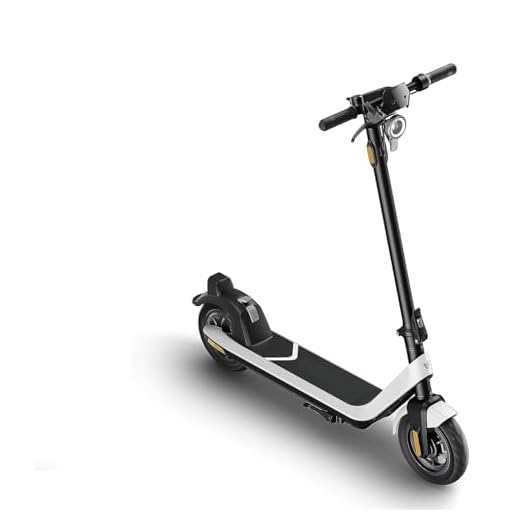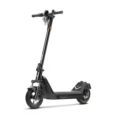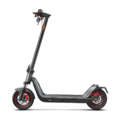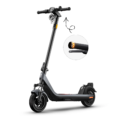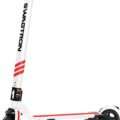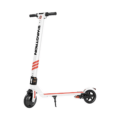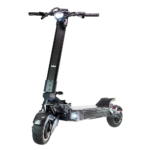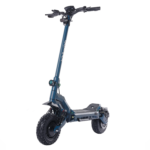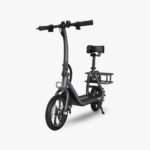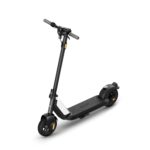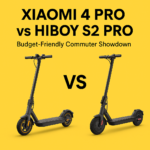- Home
- Scooters
- Electric Scooters
- NIU KQi2 Pro
NIU KQi2 Pro
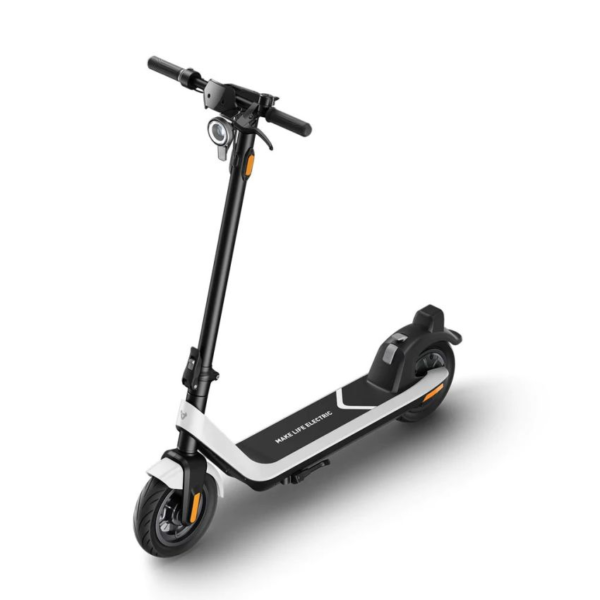

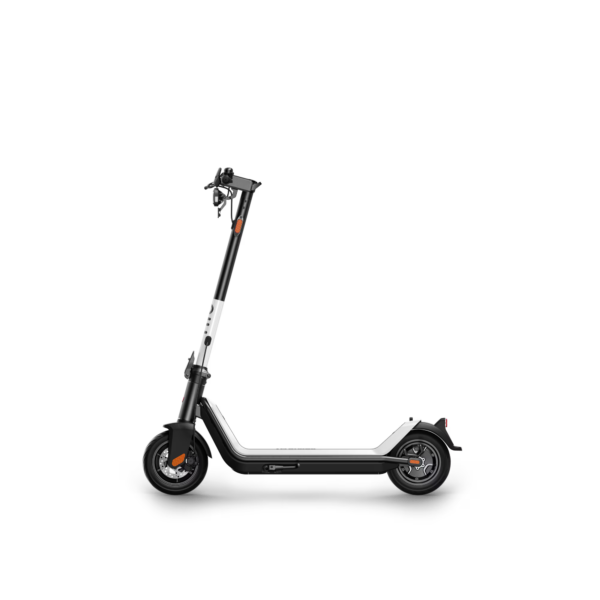
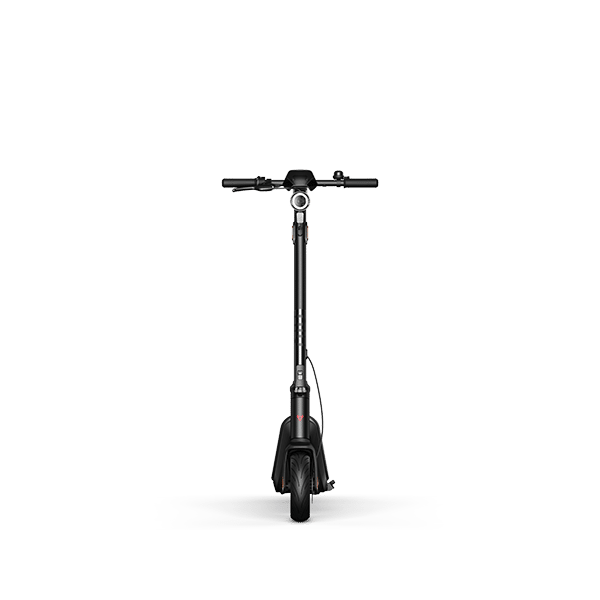
- Battery Range: 24.9 miles (40 km)
- Top Speed: 17.4 mph (28 km/h)
- Motor Power: Rated 300 W
- Weight Capacity: 220 lbs (100 kg)
- Charging Time: ~7 hours
- Scooter Weight & Portability: 40.6 lbs (18.4 kg)
PROS
- Stable ride with wide deck and tires
- Smart app with firmware updates and customization
- Solid battery range (25 miles) for daily commutes
- Durable aluminum frame and clean wire design
- Two-year warranty adds long-term peace of mind
CONS
- Moderate top speed (17.4 mph)
- Relatively slow uphill
- No suspension, so rough roads are felt more
Introduction: A Scooter Built for Practical Commuters
The NIU KQi2 Pro Specifications showcase a scooter designed to meet the everyday needs of commuters and casual riders. It doesn’t try to chase extreme speeds or premium features. Instead, it delivers what matters most: dependable performance, consistent range, comfortable ergonomics, and smart technology integration.
With a 300 W motor (600 W peak), the KQi2 Pro reaches 17.4 mph—enough for safe city travel. Its 365 Wh battery delivers a maximum of 25 miles per charge, which covers the needs of most daily riders. Combined with wide 10-inch tires, a sturdy aluminum frame, and app support, the scooter represents one of the most balanced options in its class.
Moreover, NIU has built the scooter with durability in mind. It comes with an IP54 water-resistance rating, a reinforced deck, and a two-year warranty on core components. All of this positions the KQi2 Pro as a mid-range scooter that is approachable for first-time riders and satisfying for more experienced commuters.
This overview explores every aspect of the scooter in detail: from motor power and battery life to comfort, portability, safety, technology, real-world rider feedback, and comparisons with competitors. By the end, you’ll see why the KQi2 Pro is one of the most reliable options for practical riders today.
Motor & Speed: Power That Balances Safety and Efficiency
The NIU KQi2 Pro Specifications list a 300 W rear hub motor, capable of reaching a top speed of 17.4 mph. At first glance, this may seem modest compared to scooters that exceed 20 mph or more. However, NIU has deliberately chosen this performance level to balance efficiency, safety, and real-world commuting needs.
Acceleration is smooth and gradual rather than abrupt. From a complete stop, the scooter reaches 10 mph in about 4 seconds and climbs toward its top speed within 6–7 seconds. This controlled acceleration reduces the chances of instability, especially for new riders. It also makes the scooter easier to manage in crowded urban environments where sudden starts could be unsafe.
Another advantage of the motor is its rear-wheel drive layout. Many budget scooters use front-wheel drive, which can slip under acceleration on wet or dusty roads. By placing the drive at the rear, the KQi2 Pro maintains better traction and stability. Riders feel more confident accelerating from traffic lights or climbing gentle slopes without the front wheel losing grip.
On inclines, the scooter handles up to 15% grades. While it slows to around 10–12 mph on steeper hills, it maintains momentum for riders under the 220 lb weight limit. For commuters living in moderately hilly areas, this capability is sufficient, though extremely steep terrain may still pose challenges.
When compared to competitors like the Xiaomi 1S or GoTrax G4, the KQi2 Pro holds its own. It matches or slightly exceeds their acceleration while delivering smoother power. Against the Segway Ninebot MAX G30, it is slower, but it also costs less and weighs less—showing NIU’s decision to prioritize accessibility over outright performance.
Ultimately, the motor setup reflects NIU’s design philosophy: not too fast, not too weak, but perfectly suited for predictable and safe commuting.
Battery & Range: Consistent Power for Daily Commutes
Range is one of the most important factors in a commuter scooter, and the NIU KQi2 Pro Specifications highlight a 365 Wh lithium-ion battery that provides up to 25 miles per charge. For most urban riders, this translates to multiple days of commuting without needing to recharge.
In real-world conditions, range varies based on rider weight, terrain, and riding style. A 150 lb rider cruising at 12–15 mph can expect to cover nearly the full 25 miles. Heavier riders or those using Sport mode consistently may see closer to 18–20 miles. Even so, this remains sufficient for typical city commutes of 3–5 miles each way.
Charging the battery takes about 7 hours, making it best suited for overnight charging. Riders can simply plug it in before bed and wake up to a full charge. For those using the scooter daily, this routine quickly becomes seamless.
Beyond simple numbers, the real value lies in NIU’s Battery Management System (BMS). The 14-point BMS constantly monitors voltage, temperature, and charge cycles. It prevents overcharging, protects against overheating, and stops deep discharge that could damage the cells. These safeguards not only keep riders safe but also extend the life of the battery.
Another practical benefit is how the scooter handles seasonal changes. In colder weather, many lithium batteries lose significant range. The KQi2 Pro’s battery still experiences reduced efficiency in low temperatures, but thanks to the BMS and smart cell arrangement, the loss is less severe compared to cheaper scooters. Riders in cold climates can still rely on it for everyday travel, albeit with slightly shorter distances.
Compared to competitors, the KQi2 Pro’s range is highly competitive. It outperforms entry-level Xiaomi models and rivals GoTrax scooters in the same price bracket. Only higher-end models like the NIU KQi3 Pro or Segway MAX surpass it—but at a higher cost and weight.
For riders seeking a scooter that balances charging time, safety, and real commuting distance, the KQi2 Pro’s battery system is a standout feature.
Comfort & Design: A Stable and Rider-Friendly Setup
Comfort is often overlooked in mid-range scooters, but the NIU KQi2 Pro Specifications emphasize ergonomics. The scooter features a 20-inch deck, which is 13% larger than many entry-level scooters, and 20.5-inch handlebars, which are 20% wider than standard. Together, these upgrades create a stable, roomy platform that feels natural even on longer rides.
The 10-inch pneumatic tubeless tires provide excellent cushioning. While the scooter does not include built-in suspension, the tires act as shock absorbers, softening the feel of cracks, bumps, and uneven surfaces. Their 2.3-inch width also provides more grip than thinner tires, adding confidence when cornering.
Riders often mention that the stance feels relaxed and supportive. The wider deck allows for varied foot placement, reducing fatigue on trips longer than 5 miles. The handlebars also improve posture, keeping wrists in a neutral position and shoulders relaxed. This ergonomic design makes the scooter suitable for taller riders who often find compact scooters cramped.
The deck surface uses skateboard-inspired grip tape rather than smooth rubber. This keeps feet secure, especially in wet conditions, and adds a layer of durability. Even after months of use, the tape resists peeling or wearing down.
Visually, the scooter maintains NIU’s sleek, minimal aesthetic. The wiring is neatly routed, the paint finish is clean, and the overall build feels premium compared to its price. It looks like a product designed to last, not just a disposable commuter tool.
All these design elements contribute to a riding experience that feels safe, stable, and comfortable. For commuters who prioritize daily usability over flashy extras, the KQi2 Pro delivers exactly what’s needed.
Braking & Safety: A Thoughtful Dual System
Braking is just as critical as acceleration, and the NIU KQi2 Pro Specifications highlight a dual braking system: a front drum brake paired with a rear regenerative brake.
The drum brake provides strong mechanical stopping power while requiring minimal maintenance compared to disc brakes. It is less exposed to dirt and water, meaning it performs reliably in different weather conditions. The regenerative brake adds an extra layer of control, gently slowing the scooter while feeding a small amount of energy back into the battery.
Together, these brakes deliver smooth, progressive stopping. Riders don’t experience sudden jolts or skidding, which can happen with scooters that rely only on mechanical systems. Instead, the scooter slows predictably, giving riders confidence in both dry and wet conditions.
Lighting is another area where NIU has invested effort. The scooter features a halo daytime running light that remains on during all rides. This ensures that riders are visible to cars and pedestrians even in daylight. At night, the headlight projects a strong beam, illuminating up to 10 meters ahead. The rear taillight brightens automatically during braking, and side reflectors further improve visibility.
In combination, the braking and lighting systems make the KQi2 Pro one of the safer scooters in its category. It may not include advanced features like turn signals found on higher-end NIU models, but for its price point, it provides more than enough safety for daily commuting.
Portability & Build Quality: Sturdy but Practical
At 40.6 lbs, the KQi2 Pro sits in the mid-weight category. While it isn’t ultralight like the NIU KQi Air X, it remains manageable for most riders. The one-step folding mechanism allows the scooter to collapse quickly, making it easy to store at home, in offices, or in car trunks. When folded, the scooter measures about 45.2 × 20.5 × 20.5 inches, compact enough for tight storage spaces.
The weight reflects NIU’s focus on durability. The frame is made from aerospace-grade aluminum, which balances strength with relative lightness. Riders often remark that the scooter feels solid and premium, with no rattling joints or weak folding points. Over months of daily use, the frame resists bending, creaking, or loosening—a common issue with cheaper scooters.
Carrying the scooter upstairs or onto public transport is feasible, though not effortless. For riders who need to carry their scooter frequently, the weight might feel cumbersome. However, for those who only occasionally lift it, the balance between sturdiness and portability is acceptable.
Overall, the build quality sets the KQi2 Pro apart from disposable entry-level models. It is designed not just for short-term use but for years of daily commuting.
Smart Features: Connectivity That Enhances the Ride
A defining part of the NIU KQi2 Pro Specifications is its suite of smart features. Through the NIU app, riders can connect via Bluetooth to access detailed ride statistics, adjust speed settings, activate cruise control, and even lock the scooter remotely.
The app also supports over-the-air (OTA) firmware updates, ensuring that the scooter’s software remains up-to-date. This means performance tweaks and new features can be delivered without visiting a service center. For riders, this future-proofs the scooter, keeping it relevant even as technology advances.
On the scooter itself, an LED dashboard displays speed, battery level, and mode selection. Riders can choose from four modes: E-Save, Sport, Custom, and Pedestrian. E-Save conserves battery by limiting top speed, Sport unlocks full performance, Custom allows personalized settings, and Pedestrian limits speed for shared paths or crowded areas.
Cruise control is another appreciated feature. On longer straight paths, it maintains a steady speed, reducing hand fatigue. Riders find this especially useful for daily commutes where consistent speed is preferred over constant throttle adjustments.
The combination of app features and on-board controls makes the scooter feel modern and user-friendly. Unlike basic models that only display battery bars and speed, the KQi2 Pro provides a connected experience that adds real value.
Durability & Long-Term Ownership: Built to Last
Durability is a critical factor for commuters who plan to use their scooter daily, and the NIU KQi2 Pro Specifications reflect thoughtful engineering. With an IP54 water-resistance rating, the scooter withstands light rain and puddles. Riders should still avoid heavy downpours, but the rating ensures it won’t fail from splashes or mist.
The use of pneumatic tubeless tires reduces the risk of flats compared to tube tires. They also maintain air pressure better over time, requiring fewer adjustments. Maintenance typically involves occasional tire inflation and brake adjustments, both of which are straightforward.
The regenerative braking system reduces wear on the front drum brake, extending its lifespan. Many riders report that even after months of daily use, the braking performance remains consistent.
NIU backs the scooter with a two-year warranty, covering the motor, battery, and frame. This warranty period exceeds many competitors, which often limit coverage to one year. It reflects NIU’s confidence in its product and provides riders with added assurance.
In practice, the KQi2 Pro holds up well over long-term use. Owners mention that it remains quiet and stable even after hundreds of miles, with minimal creaking or structural issues. This durability adds to its overall value, making it more than just an entry-level option.
Real-World Feedback: What Riders Say
Rider feedback consistently highlights the KQi2 Pro’s strengths in stability, comfort, and reliability. Many users note that the scooter feels sturdier than budget options and delivers a smoother ride thanks to its wide deck and pneumatic tires.
Range is frequently praised, with riders confirming that real-world mileage matches NIU’s advertised 25 miles under moderate riding conditions. Lighter riders often achieve even more, while heavier riders still find the range sufficient for daily needs.
The braking system receives positive reviews for its predictability. Riders say it slows smoothly, avoiding the abruptness of scooters with only mechanical brakes. The halo light is another popular feature, drawing compliments for its visibility in both day and night conditions.
Criticism is limited but worth noting. Some riders wish the scooter had a higher top speed, especially for longer commutes. Others mention that the lack of suspension makes rough roads less comfortable, though the 10-inch tires help mitigate this.
Overall, real-world impressions confirm what the specifications suggest: the KQi2 Pro is a balanced, reliable commuter scooter that delivers exactly what most riders need.
Comparisons: How It Stacks Up Against Competitors
When placed alongside its competitors, the NIU KQi2 Pro Specifications reveal a scooter that excels in balance.
- Versus Xiaomi 1S: The KQi2 Pro offers wider handlebars, a more spacious deck, better lighting, and smart app integration. While the Xiaomi is slightly lighter, it feels less stable and lacks the same safety features.
- Versus Segway Ninebot MAX G30: The Segway provides longer range (up to 40 miles) and higher speed. However, it is significantly heavier and more expensive. Riders seeking portability and affordability may prefer the KQi2 Pro.
- Versus GoTrax G4: The GoTrax matches range but lacks the same build quality and app features. NIU’s two-year warranty also gives the KQi2 Pro an advantage in long-term value.
- Versus NIU KQi3 Pro: The KQi3 Pro surpasses the KQi2 Pro in range and motor power. Yet, the KQi2 Pro holds its place as a lighter, more affordable option that still includes essential features.
These comparisons show that the KQi2 Pro competes strongly in its segment, offering a smart middle ground between performance, price, and features.
Value for Money: A Balanced Investment
For its price range, the KQi2 Pro delivers excellent value. Riders receive a strong frame, safe braking, smart app connectivity, dependable range, and thoughtful design—all backed by a two-year warranty.
It may not satisfy those chasing maximum speed or extreme hill-climbing ability. However, for everyday commuters, students, or casual riders, it checks every box: safety, comfort, efficiency, and durability.
Over time, the scooter proves its worth by requiring minimal maintenance, holding charge consistently, and offering reliable performance. Compared to budget models that often break within a year, the KQi2 Pro stands out as a smarter long-term investment.
Final Verdict
The NIU KQi2 Pro Specifications confirm that this scooter is one of the best commuter options in its class. With a reliable 300 W motor, practical 25-mile range, ergonomic design, dual braking system, and app connectivity, it balances safety and convenience.
Yes, it has limitations: a modest top speed, no suspension, and average hill-climbing ability. Yet these trade-offs are acceptable given its affordability and durability. For riders who want a dependable scooter that blends smart features with daily usability, the NIU KQi2 Pro is a top-tier choice.
Specifications
General
| Model The Model specifies the exact version or name of the scooter. It helps identify its unique design, features, and specifications within the manufacturer’s product line. Knowing the model makes it easier to compare options, find compatible accessories, or look up support information. | KQi2 Pro |
| Brand The Brand identifies the manufacturer or company that designs and produces the scooter. A trusted brand is a sign of quality, reliability, and good customer support. Well-known brands often have higher standards for safety, performance, and after-sales service, giving you more confidence in your purchase. | NIU |
| Release Date The Release Date indicates when the scooter model was officially launched on the market. This helps you know how current the design, technology, and features are. A newer release date often means updated components, improved performance, and the latest safety or smart features. | 01 January 2022 |
| Recommended Age Recommended Age indicates the minimum age range that the scooter is designed for, based on safety, size, and ease of use. Following the recommended age helps ensure that riders can handle the scooter’s speed, weight, and controls comfortably and safely. Always check local laws and use protective gear, especially for younger riders. | 14+ |
Performance & Power
| Motor Power (Wattage) What it means: The motor power, measured in watts (W), shows how strong the scooter’s electric motor is. Why it matters: Higher wattage usually means better acceleration, more torque, and improved performance on hills or rough terrain. For example, a 250W motor is good for flat city roads and light riders, while a 500W or 1000W motor provides more power for faster speeds or climbing steep inclines. | 300 W rated, up to 600 W peak |
| Top Speed The Top Speed indicates the maximum speed that the scooter can reach under optimal conditions. It’s usually measured on level ground with a fully charged battery and an average rider weight. A higher top speed allows you to travel longer distances faster, but always ensure you ride within legal speed limits and your personal comfort zone for safety. | 17.4 mph (28 km/h) |
| Battery Capacity Battery Capacity refers to the total amount of energy the scooter’s battery can store, usually measured in ampere-hours (Ah) or watt-hours (Wh). A higher battery capacity means you can ride longer distances on a single charge, reducing the need for frequent recharging. Keep in mind that actual range can vary depending on rider weight, terrain, speed, and weather conditions. | 365 Wh (48 V, 7.6 Ah) |
| Estimated Range per Charge The Estimated Range per Charge indicates the average distance the scooter can travel on a single full battery charge. This range is calculated under optimal conditions, such as flat terrain, moderate speed, and average rider weight. Real-world range may vary depending on riding style, terrain, weather, and load. A longer range means fewer recharges and greater freedom for longer trips. | Up to 24.9 miles (40 km) |
| Hill Climb Ability Hill Climb Ability describes the maximum incline or slope that the scooter can handle while maintaining stable performance. It’s typically expressed as a percentage or in degrees. A higher hill climb rating means the scooter can tackle steeper hills without losing too much speed or power. Actual climbing performance may vary based on rider weight, battery charge, and terrain conditions. | Up to 15% grade |
| Drive System The Drive System refers to how power from the motor is delivered to the wheels. Electric scooters typically use either a hub motor (directly integrated into the wheel) or a chain/belt drive system. A high-quality drive system ensures smooth acceleration, efficient power transfer, and low maintenance. The choice of drive system affects performance, noise level, and overall ride experience. | Rear-wheel drive |
Charging & Electrical
| Charging Time Charging Time indicates how long it takes to fully recharge the scooter’s battery from empty to 100% using the standard charger provided. Faster charging means less downtime and more time on the road. Actual charging time may vary slightly depending on battery capacity, charger output, and environmental conditions. | ~7 hours |
| Battery Type Battery Type refers to the specific technology used in the scooter’s battery, which affects performance, lifespan, weight, and charging time. Most modern electric scooters use high-quality lithium-ion (Li-ion) batteries because they offer a good balance of energy density, durability, and low maintenance. A reliable battery type ensures consistent power delivery and longer riding ranges. | 48 V lithium-ion with NIU ENERGY® 14-point BMS |
| Removable Battery A Removable Battery means the battery pack can be easily detached from the scooter for convenient charging and replacement. This feature allows you to charge the battery separately, swap it with a spare for extended range, or securely store it indoors in extreme weather. Removable batteries add flexibility and make it easier to keep your scooter powered up wherever you are. | No |
| Regenerative Braking Regenerative Braking is an energy-saving feature that converts some of the energy normally lost during braking back into battery power. When you slow down or brake, the motor works in reverse to generate electricity, which helps extend the scooter’s range and improves overall efficiency. This system also reduces wear on traditional brake components, leading to lower maintenance over time. | Yes |
| Lighting Lighting refers to the built-in front and rear lights that enhance visibility and safety when riding in low-light conditions or at night. Good lighting helps you see the road ahead and ensures that other road users can see you. Many scooters include LED headlights, taillights, and sometimes brake lights or side reflectors for added safety and compliance with local traffic regulations. | Halo daytime light, front/rear LEDs, side reflectors, mechanical bell |
Build & Dimensions
| Scooter Weight Scooter Weight refers to the total weight of the scooter when fully assembled, including the battery. This affects how easy it is to carry, lift, and store the scooter when not in use. A lighter scooter is more portable and convenient for commuting, especially if you need to carry it upstairs or onto public transport. Keep in mind that a sturdy frame and quality components may add to the weight but also contribute to better durability and ride stability. | 40.6 lbs (18.4 kg) |
| Maximum Rider Weight Maximum Rider Weight indicates the highest rider weight that the scooter is designed to safely support while maintaining optimal performance and stability. Staying within this limit helps ensure reliable acceleration, braking, and climbing ability, and it protects the frame, suspension, and motor from excessive strain. Exceeding the recommended limit may reduce performance and increase wear on components. | 220 lbs (100 kg) |
| Deck Size Deck Size refers to the dimensions of the scooter’s standing platform. A wider and longer deck provides more foot space, allowing you to stand comfortably and adjust your stance while riding. A well-sized deck improves balance and stability, especially on longer rides or at higher speeds. Compact decks, on the other hand, help keep the scooter lightweight and portable. | 20.0 × 5.2 in (50.7 × 13.3 cm) |
| Handlebar Height Handlebar Height refers to the distance from the deck to the handlebars, which affects your riding posture and comfort. An appropriate handlebar height helps you maintain good balance, reduces strain on your back and arms, and makes steering more comfortable. Some scooters have adjustable handlebars to fit riders of different heights, while others have a fixed height for a streamlined design. | 47.0 in; width 20.5 in (52 cm) |
| Folding Mechanism The Folding Mechanism describes how easily and securely the scooter can be folded for carrying and storage. A well-designed folding system lets you quickly collapse the scooter into a compact size, making it convenient to transport on public transit, store under a desk, or fit into a car trunk. Look for sturdy latches and safety locks to ensure the scooter stays firmly in place when folded or unfolded. | Yes |
| Dimensions Folded Dimensions indicate the size of the scooter when it’s fully folded. This measurement shows how much space the scooter will take up when stored or carried, making it easier to check if it will fit in your car trunk, under a desk, or in a closet. Compact folded dimensions are ideal for commuters who need to bring their scooter on public transport or store it in tight spaces. | 45.2 × 20.5 × 20.5 in (1147 × 520 × 520 mm) |
| Material Material refers to the primary construction materials used for the scooter’s frame and key components. High-quality materials like aircraft-grade aluminum, reinforced steel, or durable composites provide strength, stability, and a lighter overall weight. A sturdy material ensures the scooter can handle daily wear and tear while maintaining safety and performance. | Aerospace-grade aluminum frame |
Safety & Control
| Brake Type(s) Brake Type(s) describe the braking systems the scooter uses to help you slow down or stop safely. Common brake types include mechanical brakes (like drum or disc brakes), electronic brakes, and foot brakes. Many scooters combine multiple braking systems for added safety and shorter stopping distances. The type and quality of brakes affect your control, especially when riding at higher speeds or on slopes. | Front drum brake + regenerative rear brake |
| Suspension Suspension refers to the system that absorbs shocks and vibrations while riding, providing a smoother and more comfortable ride over uneven or rough surfaces. Scooters may have front suspension, rear suspension, or dual suspension for better shock absorption and stability. Good suspension helps reduce rider fatigue and improves control, especially when riding on bumpy roads or off-road paths. | None |
| Tire Type Tire Type refers to the kind of tires the scooter uses, which directly affects ride comfort, traction, and maintenance. Common types include solid (airless) tires, pneumatic (air-filled) tires, or hybrid options. Pneumatic tires offer better shock absorption and a smoother ride on rough surfaces, while solid tires are puncture-proof and require less upkeep. The right tire type helps ensure safe handling and a comfortable ride in different conditions. | 10″ × 2.3″ tubeless pneumatic tires |
| Tire Size Tire Size indicates the diameter and width of the scooter’s tires, which affect ride comfort, stability, and how well the scooter handles different terrains. Larger tires generally offer better shock absorption and a smoother ride over bumps and rough surfaces, while smaller tires keep the scooter lighter and more portable. Choosing the right tire size helps ensure a balance between agility and comfort. | 10″ |
| Kickstand The Kickstand is a built-in stand that allows you to park your scooter upright when it’s not in use. A sturdy kickstand keeps the scooter stable and prevents it from tipping over, protecting it from scratches and damage. It also makes storing and accessing your scooter more convenient, whether you’re at home, work, or on the go. | Yes |
| Water Resistance Rating Water Resistance Rating indicates how well the scooter is protected against water and moisture, usually shown as an IP (Ingress Protection) rating. This rating helps you understand whether the scooter can handle light rain, splashes, or wet roads without damage. While most scooters are not fully waterproof, a good water resistance rating adds peace of mind when riding in changing weather conditions. Always avoid deep puddles or submerging the scooter to protect its electrical components. | IP54 |
Features & Extras
| Display/Console The Display (or Console) shows important real-time information about your ride, helping you monitor your scooter’s status at a glance. Typical displays show speed, battery level, distance traveled, and riding mode. Some models also include additional features like Bluetooth connectivity, app integration, or backlighting for better visibility at night. A clear and easy-to-read display enhances safety and convenience on every trip. | LED dashboard (speed, battery, mode) |
| Ride Modes Ride Modes refer to the different speed and power settings you can choose to match your riding style or road conditions. Common modes include eco for maximum range and energy efficiency, standard for everyday balance, and sport or turbo for higher speed and stronger acceleration. Switching between ride modes allows you to customize performance, conserve battery, and ride safely in various environments. | 4 modes: E‑Save, Sport, Custom, Pedestrian; includes Cruise Control |
| Smart App Connectivity Smart App Connectivity lets you pair your scooter with a dedicated mobile app via Bluetooth. Using the app, you can monitor real-time ride stats like speed, battery level, and range, adjust settings such as ride modes or cruise control, lock the scooter for added security, and sometimes receive firmware updates. This feature adds convenience and allows you to personalize your riding experience right from your smartphone. | Yes |
| Anti-Theft System The Anti-Theft System helps protect your scooter from unauthorized use or theft. This feature can include built-in alarms, electronic motor locks, GPS tracking, or remote locking through a mobile app. A good anti-theft system provides peace of mind when parking your scooter in public spaces, adding an extra layer of security to safeguard your investment. | App lock |
| Cruise Control Cruise Control allows you to maintain a steady speed without continuously holding the throttle. This feature makes longer rides more comfortable by reducing hand fatigue and providing a smoother, more relaxed riding experience — especially on flat, open roads or bike lanes. For safety, cruise control can usually be easily activated or deactivated while riding. | Yes |
| Accessories Included Accessories Included lists the additional items that come with the scooter to enhance your riding experience and convenience. Common accessories may include a charger, kickstand, bell, lights, phone holder, or carrying strap. These extras add value by making your scooter safer, easier to use, and ready to ride straight out of the box. | Charger, manual, tools (standard) |
Warranty & Compliance
| Warranty Period The Warranty Period indicates how long the manufacturer guarantees the scooter against defects in materials and workmanship under normal use. A good warranty provides peace of mind, showing the brand’s confidence in its product quality. Always check what parts are covered, such as the frame, battery, and motor, and follow the maintenance guidelines to keep your warranty valid. | 2 years |
| Certifications Certifications confirm that the scooter meets specific safety, quality, and environmental standards set by recognized organizations or regulatory bodies. Common certifications may include CE, RoHS, UL, or other local compliance marks, depending on your region. These certifications ensure that the scooter is manufactured to high standards and is safe and legal to use in your country. | IP54 rating; UL-listed where applicable |



